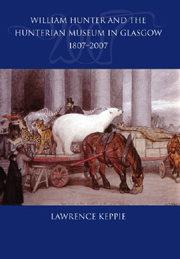Book contents
- Frontmatter
- Contents
- Foreword by Sir Kenneth Calman
- Introduction
- List of Illustrations
- Acknowledgements
- Abbreviations used in the Notes
- Dedication
- 1 William Hunter's Life and Career
- 2 Growth of the Hunterian Collection
- 3 ‘The Noblest Legacy upon Record’
- 4 A Temple of the Muses: the First Hunterian Museum in Glasgow
- 5 ‘This Place of Fascination’: the Impact of the Museum, 1807–70
- 6 A New Museum for a New University, 1870–1900
- 7 The Twentieth Century: War, Peace and Renewal, 1900–75
- 8 The Hunterian Art Gallery
- 9 Modern Times, 1975–2007
- 10 Overview: Meeting William Hunter's Intentions
- Postscript: Looking to the Future
- Notes
- Appendix: Catalogues of the Hunterian Collections
- Bibliography
- Index
- Plate section
4 - A Temple of the Muses: the First Hunterian Museum in Glasgow
Published online by Cambridge University Press: 12 September 2012
- Frontmatter
- Contents
- Foreword by Sir Kenneth Calman
- Introduction
- List of Illustrations
- Acknowledgements
- Abbreviations used in the Notes
- Dedication
- 1 William Hunter's Life and Career
- 2 Growth of the Hunterian Collection
- 3 ‘The Noblest Legacy upon Record’
- 4 A Temple of the Muses: the First Hunterian Museum in Glasgow
- 5 ‘This Place of Fascination’: the Impact of the Museum, 1807–70
- 6 A New Museum for a New University, 1870–1900
- 7 The Twentieth Century: War, Peace and Renewal, 1900–75
- 8 The Hunterian Art Gallery
- 9 Modern Times, 1975–2007
- 10 Overview: Meeting William Hunter's Intentions
- Postscript: Looking to the Future
- Notes
- Appendix: Catalogues of the Hunterian Collections
- Bibliography
- Index
- Plate section
Summary
Making ready ‘a fit and commodious house’
In June 1798, the matter of a museum building at the College in Glasgow was delegated by the Faculty to the ‘Summer Committee’ who were ‘to examine particularly all the different situations in and about the College, that in their opinion, might answer for the Hunterian Museum, and to examine the latter will of Doctor Hunter to see how far any particular situation is suggested for the same.’ In October 1799 Matthew Hunter Baillie emphasised to the Faculty that the Museum should be a ‘distinct building’ and placed in ‘a conspicuous situation’. Perhaps Baillie had got wind of a plan to include the Museum in a comprehensive redevelopment of the east wing of the inner quadrangle, this to include a new Common Hall and classrooms. Indeed some professors felt that placing the Museum in the garden would mar its tranquillity. At first the former option seemed likely to win out, but it was eventually voted down, and Matthew Baillie was informed by letter in December 1800 of a decision in favour of the garden (Figure 4.1).
In the event, the College did not have to wait the full thirty years to obtain the use of the collection. William Cruikshank, one of the beneficiaries of William's forethought on this matter, died in 1800, by which time Matthew Hunter Baillie had already given up the teaching of anatomy, and other anatomical specimens were available to their successors at Great Windmill Street.
- Type
- Chapter
- Information
- Publisher: Edinburgh University PressPrint publication year: 2007



